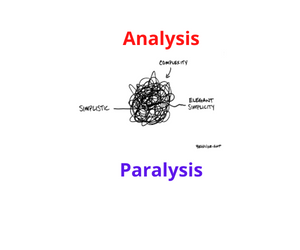“Digital” is quite the buzzword. Suddenly, there is a huge promise of jam tomorrow if we just go with the digital flow.
I am now 30 years into a career of making banks more effective & efficient. To this day, my grey haired and receded hairline friends and I are still shocked at how poorly banks have made use of the tools already at their disposal; if the leading banks were even remotely efficient the profits would inspire a popular uprising.
So what is digital and what would you have to do to be a winner in Financial Services?
I am a change guy. Bar the first two apprenticeship years at Salomon, the rest has involved changing existing processes and adding new ones, always with the goal of balancing the holy trinity for Operations of control, capacity and cost by building a great process. In all of that work, design and the user experience has played something of a role, but a limited one.
My view of process is that it is a function of People + Procedures + Systems. If you have some decent tools, good procedures, generally with a checklist and some inspired people, a lot can be achieved.
Most of my work has all been in the back-office, so largely, it has not involved the customer or client facing part. In FS, optimisation is also a function of the external infrastructure; firms have to settle trades and they can only do that as efficiently as the market mechanisms allow.
Now along comes the digital fad. What is different when you have to think about digital?
Some smart minds have some very useful thoughts to share on this subject.
The very thoughtful folk at McKinsey have published some very useful, clear guidance on this: “Good to great: What B2B companies do to raise their Digital Quotient“.
 They offer the view that to fully harness the potential of new tools, the digital journey means you have re-think the front-to-back journey. It is about re-conceiving the process, not just about moving the current process to a new toolset. Makes sense. The McKinsey updates are really worth subscribing to. Well argued and
They offer the view that to fully harness the potential of new tools, the digital journey means you have re-think the front-to-back journey. It is about re-conceiving the process, not just about moving the current process to a new toolset. Makes sense. The McKinsey updates are really worth subscribing to. Well argued and
presented view points.
Another view comes from transformation expert Rob LLewelyln. He focusses sharply on the tendency that big places have to latch on the latest trend in a Dilbertesque effort to be seen to be doing the latest thing: “The Great Digital Illusion – making the wake-up call“. He suggests that if you want your digital activities to truly transform, then the new way has either got to be disruptive or act as a barrier to disruption. Each transformation project needs a strategy, a roadmap and a transformation outcome. Read the full report for some insightful ways to challenge the projects up for consideration. I fully support Rob’s view that hard thought is needed and many projects will fail. Digital is not new in that respect; obsessive following of fads and only superficial change are the norm in an industry grown fat & complacent on super-normal profits over the years.
that big places have to latch on the latest trend in a Dilbertesque effort to be seen to be doing the latest thing: “The Great Digital Illusion – making the wake-up call“. He suggests that if you want your digital activities to truly transform, then the new way has either got to be disruptive or act as a barrier to disruption. Each transformation project needs a strategy, a roadmap and a transformation outcome. Read the full report for some insightful ways to challenge the projects up for consideration. I fully support Rob’s view that hard thought is needed and many projects will fail. Digital is not new in that respect; obsessive following of fads and only superficial change are the norm in an industry grown fat & complacent on super-normal profits over the years.
 People & structure are two other very important considerations. My colleagues from Elixirr, Brandon Bichler and David Guillebaud, have put together a very compelling podcast: Innovation & Disruptors. This delivers some valuable insights on set-up and culture.
People & structure are two other very important considerations. My colleagues from Elixirr, Brandon Bichler and David Guillebaud, have put together a very compelling podcast: Innovation & Disruptors. This delivers some valuable insights on set-up and culture.
Put peo ple at the centre of things. So says the Pope. The good folks at Inc. Magazine highlight a recent TEDTalk by the Pontiff, yes TED and Pope, no joke, so pay attention. His Holiness focussed on how many things we do in the name of progress cast people aside rather than having people as their driver. Whatever you think about Catholicism and the Catholic church, these few words deserve your time and attention.
ple at the centre of things. So says the Pope. The good folks at Inc. Magazine highlight a recent TEDTalk by the Pontiff, yes TED and Pope, no joke, so pay attention. His Holiness focussed on how many things we do in the name of progress cast people aside rather than having people as their driver. Whatever you think about Catholicism and the Catholic church, these few words deserve your time and attention.
Lessons to be Learned:
- Digital is an important driver; the tools and technology we can bring to bear offer the potential for quantum leaps in product offering, revenue and savings potential.
- Direction and design are important; it will take senior leadership. It will take a really strong programme governance to ensure the many pieces play a part in a digital transformation worthy of the title.
- People are important; the customer who will consume a good or service, as well as those along the value chain.
About the Author: I help banks master their post trade processing; optimising, re-engineering, building.
I understand the front-to-back and end-to-end impact of what banks do. That allows me to build the best processes for my clients; ones that deliver on the three key dimensions of Operations: control, capacity and cost.
Previous Posts
Are available on the 3C Advisory website, click here.
Publications
The Bankers’ Plumber’s Handbook
Control in banks. How to do operations properly.
For some in the FS world, it is too late. For most, understanding how to make things work properly is a good investment of their time. 
My book tries to make it easy for you and includes a collection of real life, true stories from nearly 30 years of adventures in banking around the world. True tales of Goldman Sachs and collecting money from the mob, losing $2m of the partners’ money and still keeping my job and keeping an eye on traders with evil intentions.
So you might like the tool kit, you might like the stories or you might only like the glossary, which one of my friends kindly said was worth the price of the book on its own. Or, you might like all of it.
Go ahead, get your copy!
Hard Copy via Create Space: Click here
Kindle version and hard copy via Amazon: Click here
Cash & Liquidity Management
An up to date view of the latest issues and how BCBS guidance that comes into force from Jan 1 2015 will affect this area of banking. Kindle and hard copy.
Hard Copy via Create Space: Click here
Amazon UK: Click here
Amazon US: Click Here
Share on:



